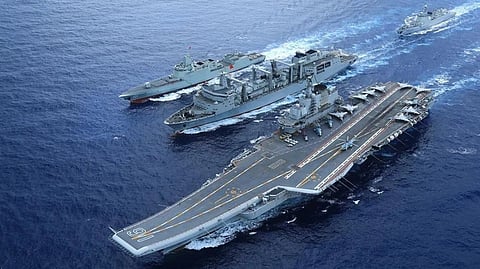COLUMN | Beijing's maritime forces increasing their presence in the South China Sea [Naval Gazing]
The waters of the South China Sea (SCS) and the islands therein are claimed by China, but the Philippines, Vietnam, Indonesia, Malaysia and Brunei each claim sovereignty over some parts of the sea, which is resource-rich and is transited by ships carrying a total of more than US$3 trillion worth of trade every year.
However, the leading authority on offshore sovereignty, the Permanent Court of Arbitration, does not recognise any one nation’s claim to sovereignty over the sea. Disputes between the claimant nations have therefore rumbled on for years.
In the 1970s, Chinese forces invaded and occupied the then Vietnam-held Paracel islands and Johnson Reef. A significant naval battle with both sides losing ships took place off Johnson Reef. Beijing subsequently helped itself to Fiery Cross, Mischief, and Subi Reefs.
China has been very aggressive in pursuit of its claim, with its maritime forces instigating many confrontations with those of some other countries that maintain competing claims. These confrontations have often included China Coast Guard (CCG) patrol ships directing jets of water from fire monitors towards Philippine Coast Guard (PCG) vessels.
Philippines and Vietnam holding the line as the US aids in protests
Manila has Washington’s backing on the issue, and is the strongest regional objector to Chinese hegemony in the sea. The PCG, and to a lesser extent the Vietnam People’s Navy, have faced up to intimidatory tactics by CCG patrol ships on numerous occasions.
America strongly supports freedom of navigation in the sea, so US Navy warships have carried much proactive surveillance of Chinese activity therein, with Washington regularly issuing protests and warnings to the Chinese.
The US, however, has recently been heavily focused on domestic politics and conflict in Europe, and its approach to SCS sovereignty issues has been relatively restrained. Unsurprisingly, Beijing has been quick to reap advantage from this probably temporary change of approach. The consequent increased presence of Chinese warships in the sea has recently included the aircraft carrier Shandong, the cruiser Yantian, and the destroyer Zhanjiang.
Manila, for its part, is considering deploying a warship to the sea in response to recent reports that CCG ships have been harassing Philippine fishing vessels.
Beijing’s pressure over the years has seldom let up, although kinetic action has thus far been avoided. Some analysts assess that there is mounting evidence that, although confrontations are likely to continue, the object of making the SCS a “Chinese Lake” has largely been achieved
Incoming US President Donald Trump’s likely approach to SCS issues remain uncertain, though, so the Chinese will likely continue to exercise a degree of caution.
So, what is the current status quo?
Recent years have seen Beijing progressively establish base facilities on rocky outcrops in the SCS, and some are equipped with both fixed armament and airfields. Some 20 of such outposts have been built in the Paracel islands, with a further seven having been constructed in the Spratly Islands.
Recent intelligence reports indicate, however, that in spite of this network of shore bases having been established, about 15 Chinese warships usually remain active in the sea in addition to CCG patrol ships. All currently operate primarily around Scarborough Shoal, a feature that has effectively been seized by Beijing in recent months.
Presence of European navies
According to some reports, Beijing is also progressively deploying warships closer to the main Philippine island of Luzon.
Current operations in the SCS seem to have attracted the attention of Moscow, with recent intelligence reports indicating that a Russian submarine has been detected in the region, apparently carrying out a surveillance mission.
There is also speculation that an Asia-bound UK Royal Navy Task Group, centred on the aircraft carrier Prince of Wales, will conduct Freedom of Navigation operations in the sea in the near future.
Why is China so determined to dominate the SCS, which has long been an international seaway?
Beijing likely has a number of motives. Firstly, it is a matter of national pride. China has claimed the sea for at least 2,000 years.
Beijing also, and perhaps most importantly, sees naval domination of the sea as an important defensive barrier. Domination of the sea facilitates constant surveillance, intelligence collection, and, if required, rapid intervention.
Some analysts also believe that Beijing might have long-term plans to make money out of sovereignty by introducing some form of levy for merchant vessels using the sea.


